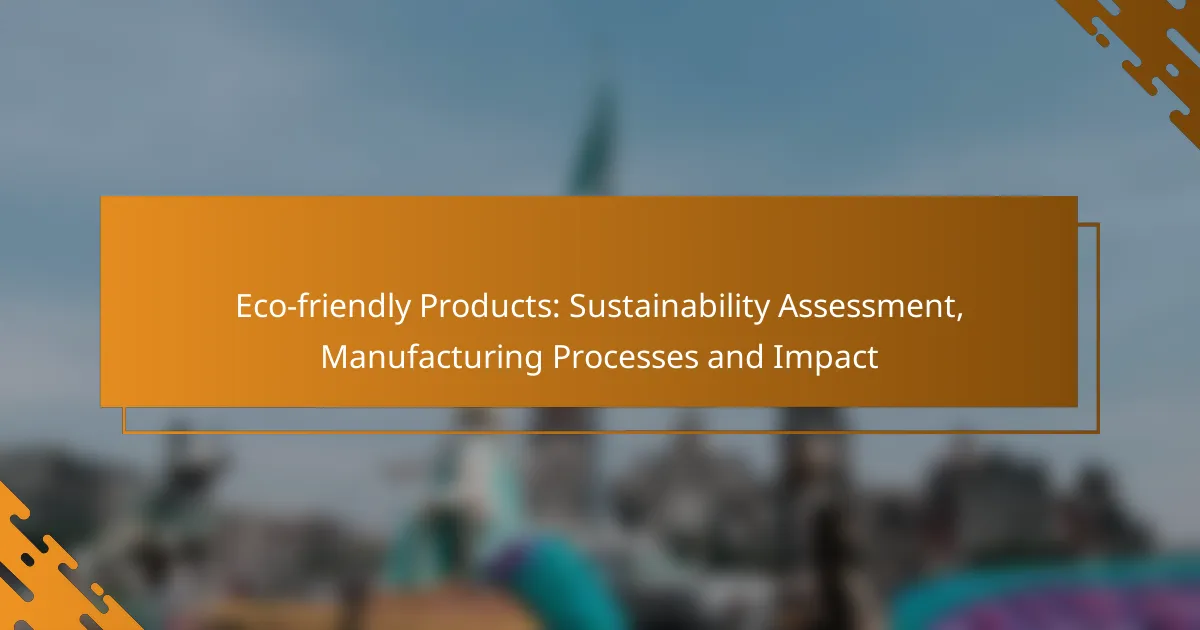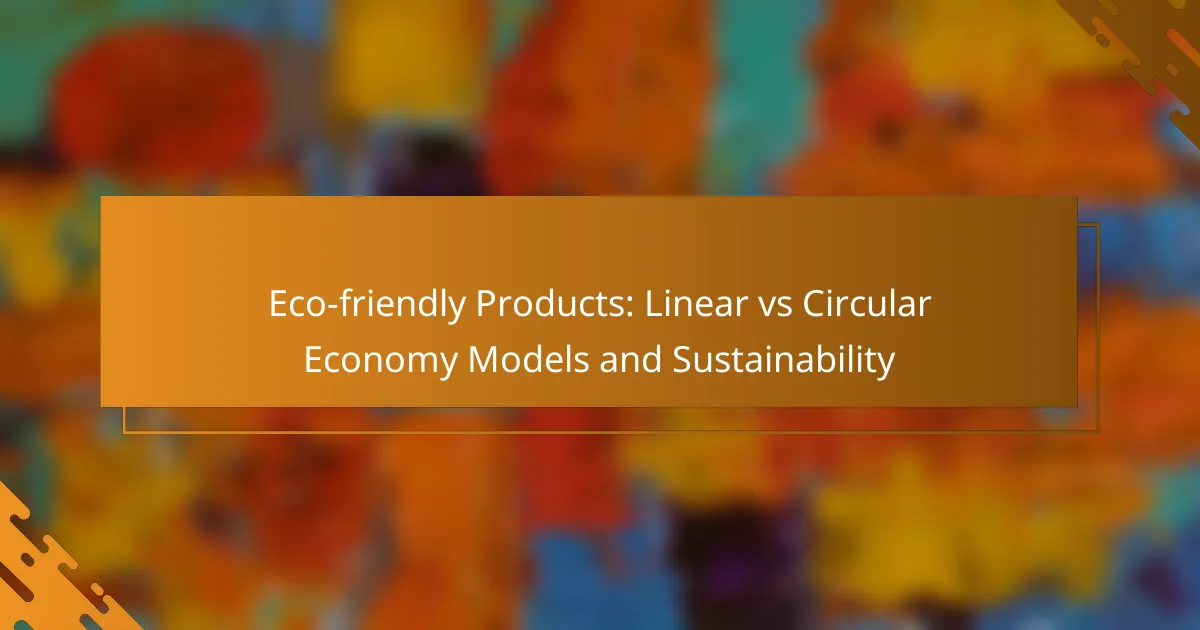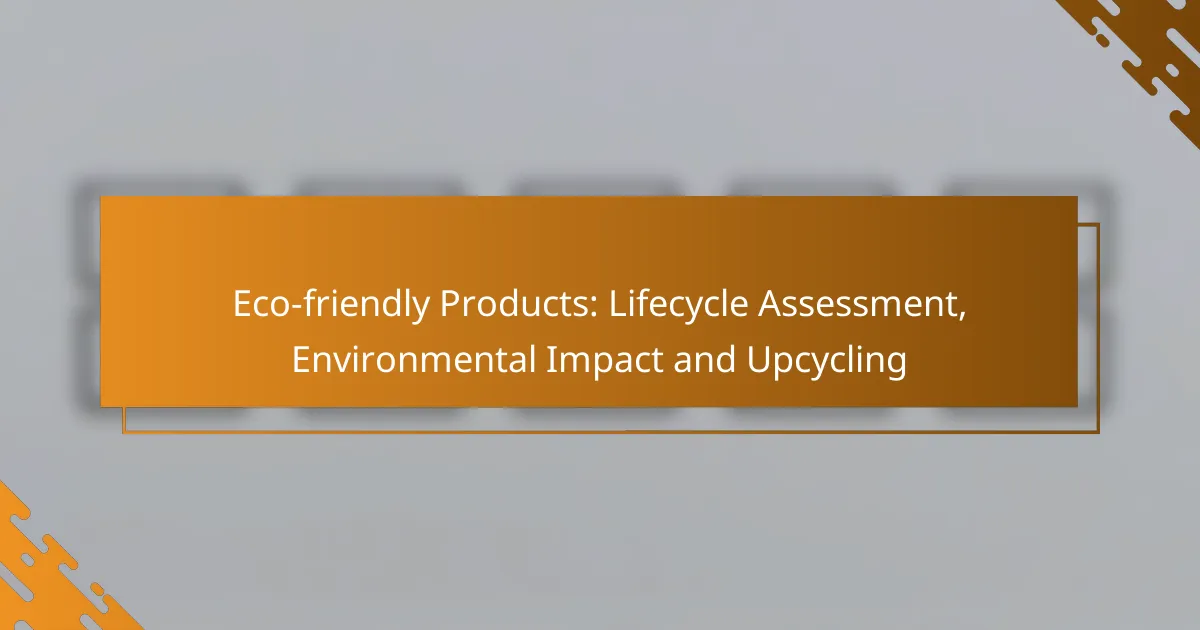Eco-friendly products play a crucial role in promoting sustainability by minimizing environmental impact and encouraging waste reduction. Upcycling, in particular, transforms discarded materials into valuable new items, fostering creativity while conserving resources. Additionally, extending the lifespan of these products through maintenance and repairs further enhances their sustainability, making them a smart choice for environmentally conscious consumers.

What are the benefits of upcycling eco-friendly products?
Upcycling eco-friendly products offers numerous advantages, including reducing waste, conserving resources, and fostering creativity. By transforming discarded materials into new items, upcycling contributes to sustainability and supports local economies.
Reduces waste in landfills
Upcycling significantly decreases the volume of waste sent to landfills. By repurposing items that would otherwise be discarded, it extends their lifecycle and minimizes the environmental impact of waste disposal.
For instance, turning old furniture into new decorative pieces not only prevents it from ending up in a landfill but also reduces the need for new materials. This practice can lead to a substantial reduction in landfill contributions over time.
Conserves natural resources
By reusing materials, upcycling conserves natural resources that would be used in the production of new products. This process helps to lower the demand for raw materials, which can lead to less deforestation, mining, and water usage.
For example, upcycling textiles into new clothing or home decor items reduces the need for new fabric production, which is resource-intensive. This conservation effort is vital in promoting a more sustainable future.
Encourages creativity and innovation
Upcycling fosters creativity by encouraging individuals to think outside the box when it comes to repurposing materials. This innovative approach can lead to unique products that reflect personal style and ingenuity.
Workshops and community events focused on upcycling often inspire new ideas and techniques, helping participants develop skills that can be applied in various creative projects. This not only enhances individual creativity but also promotes a culture of sustainability.
Supports local economies
Upcycling can stimulate local economies by creating small businesses and job opportunities. Local artisans who specialize in upcycled products often contribute to their communities by sourcing materials locally and selling their creations at local markets.
By purchasing upcycled goods, consumers support these businesses and help foster a sustainable economic model that prioritizes environmental responsibility. This can lead to a more resilient local economy.
Enhances product uniqueness
Upcycled products are often one-of-a-kind, offering consumers unique items that stand out from mass-produced alternatives. This uniqueness appeals to those looking for distinctive home decor, fashion, or gifts.
For example, a lamp made from an old bicycle wheel not only serves a functional purpose but also acts as a conversation starter. The individuality of upcycled products can enhance their value and appeal in the marketplace.

How can you extend the lifespan of eco-friendly products?
Extending the lifespan of eco-friendly products involves regular maintenance, proper storage, and opting for repairs instead of replacements. These practices not only enhance durability but also contribute to sustainability by reducing waste and resource consumption.
Regular maintenance and care
Consistent maintenance is crucial for prolonging the life of eco-friendly products. This can include cleaning, checking for wear and tear, and following manufacturer guidelines for upkeep. For instance, wooden items may benefit from periodic oiling to prevent drying and cracking.
Additionally, using appropriate cleaning materials can prevent damage. For example, biodegradable cleaners are often gentler on surfaces than harsh chemicals, preserving both the product and the environment.
Proper storage techniques
Storing eco-friendly products correctly can significantly impact their longevity. For textiles, keeping them in a cool, dry place away from direct sunlight can prevent fading and deterioration. Similarly, metal items should be stored in a moisture-free environment to avoid rust.
Using breathable storage bags or containers can also help maintain the condition of items like shoes or bags made from natural materials. Avoid overcrowding to allow air circulation, which helps prevent mold and mildew.
Repairing instead of replacing
Choosing to repair rather than replace eco-friendly products can greatly extend their lifespan. Many items, such as furniture or clothing, can be mended with simple tools and materials, reducing the need for new purchases. For example, a small tear in a fabric can often be stitched up easily, saving both money and resources.
Look for local repair shops or community workshops that offer repair services, often at a lower cost than buying new. Engaging in DIY repairs can also be a rewarding way to learn new skills while being environmentally conscious.
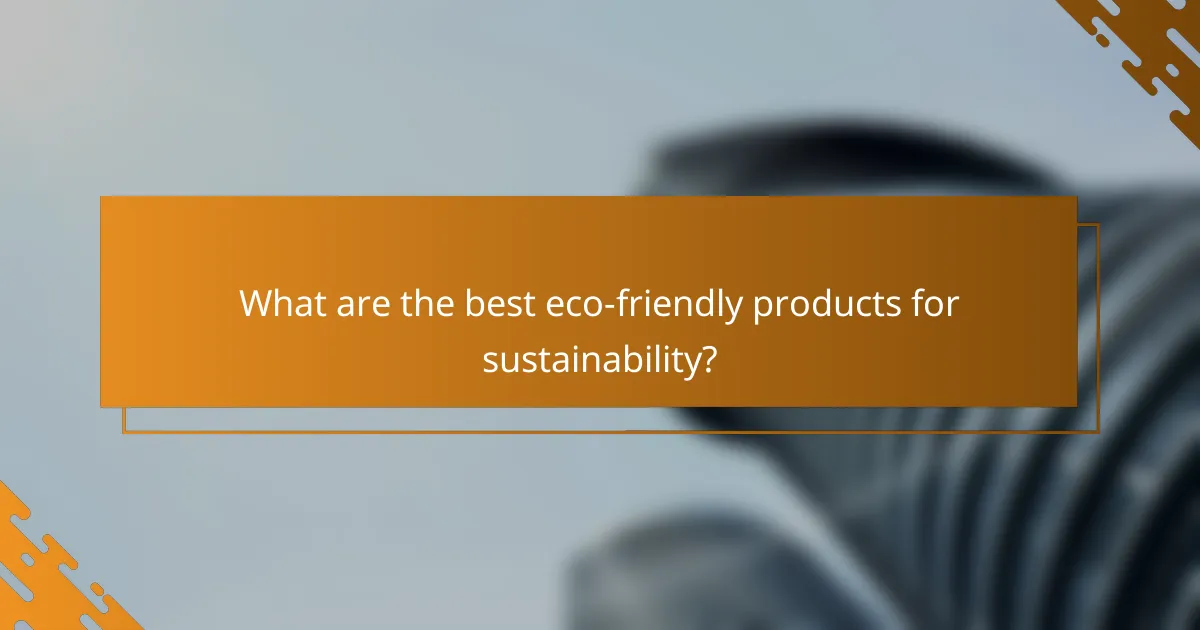
What are the best eco-friendly products for sustainability?
The best eco-friendly products for sustainability are those that minimize environmental impact while promoting reuse and reduction of waste. Key examples include reusable shopping bags, biodegradable cleaning supplies, solar-powered gadgets, and upcycled furniture.
Reusable shopping bags
Reusable shopping bags are a practical alternative to single-use plastic bags, significantly reducing plastic waste. Made from durable materials like cotton or recycled plastics, these bags can last for years with proper care.
When selecting reusable bags, consider their size, weight capacity, and ease of cleaning. Look for options that fold easily for convenience and are machine washable to maintain hygiene.
Biodegradable cleaning supplies
Biodegradable cleaning supplies break down naturally, reducing pollution and landfill waste. These products often use plant-based ingredients that are safer for both the environment and human health.
When choosing biodegradable cleaners, check for certifications such as the EPA Safer Choice label. Avoid products with harsh chemicals, as they can negate the benefits of being biodegradable.
Solar-powered gadgets
Solar-powered gadgets harness sunlight to operate, reducing reliance on traditional energy sources. Common examples include solar chargers, lights, and garden fountains, which can lower electricity bills and carbon footprints.
When purchasing solar gadgets, consider their efficiency ratings and the amount of sunlight they require for optimal performance. Look for products with durable materials to withstand outdoor conditions.
Upcycled furniture
Upcycled furniture involves repurposing old or discarded items into new, functional pieces, minimizing waste and resource consumption. This practice not only saves materials but also adds unique character to home decor.
When exploring upcycled furniture, check for quality craftsmanship and the materials used. Consider DIY projects to personalize pieces, but ensure they are safe and structurally sound before use.
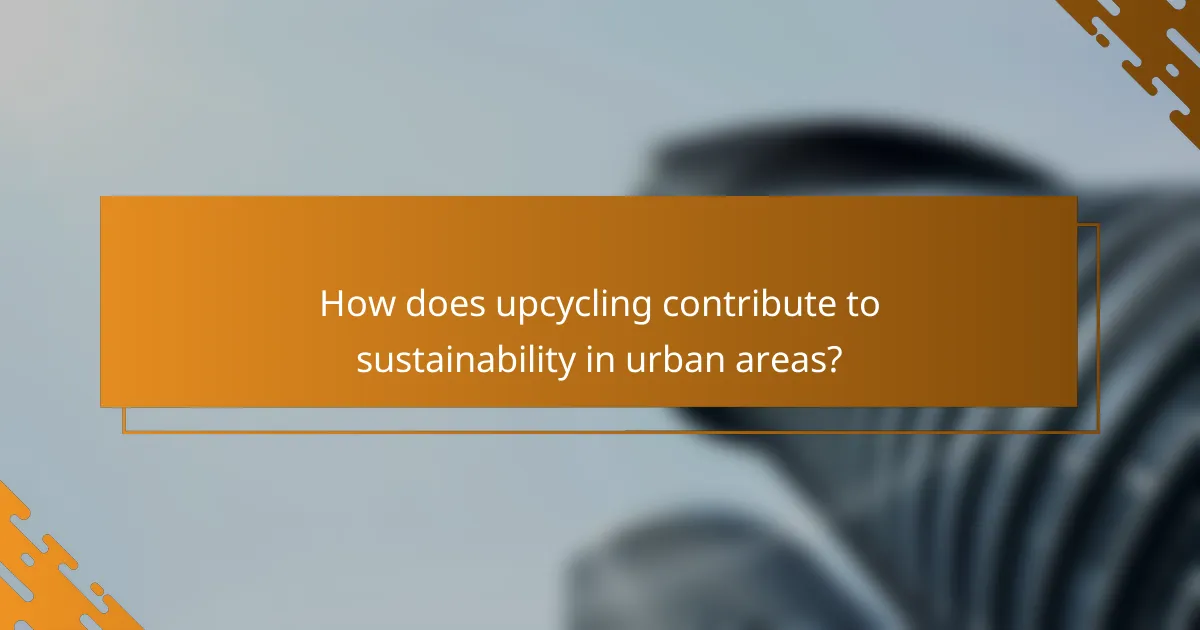
How does upcycling contribute to sustainability in urban areas?
Upcycling significantly enhances sustainability in urban areas by transforming waste materials into valuable products, thereby reducing the demand for new resources. This process not only minimizes landfill contributions but also fosters a culture of creativity and environmental responsibility among urban residents.
Reduces urban waste production
Upcycling directly reduces urban waste production by repurposing items that would otherwise be discarded. For instance, old furniture can be transformed into new decorative pieces, effectively diverting waste from landfills. This practice not only cuts down on the volume of waste but also lessens the environmental impact associated with manufacturing new goods.
Urban areas often face challenges with waste management, and upcycling provides a practical solution. By encouraging individuals to rethink their waste, cities can promote a circular economy where materials are reused, thus extending their lifecycle and reducing the need for new materials.
Promotes community engagement
Upcycling fosters community engagement by bringing people together to collaborate on projects that enhance their environment. Workshops and community events centered around upcycling can create social bonds, as residents share skills and ideas while working on creative solutions to waste issues.
Such initiatives not only strengthen community ties but also raise awareness about sustainability practices. Local organizations can host events that encourage participation, making the process of upcycling a collective effort that benefits the entire neighborhood.
Encourages local craftsmanship
Upcycling encourages local craftsmanship by inspiring artisans to create unique products from discarded materials. This practice not only showcases local talent but also supports small businesses that focus on sustainable practices. For example, a local artist might transform glass bottles into decorative lamps, adding value to what would be waste.
Furthermore, promoting local craftsmanship through upcycling can stimulate the local economy. By purchasing upcycled goods, residents support their neighbors and contribute to a more sustainable urban ecosystem, where creativity and environmental consciousness thrive together.

What criteria should you consider when choosing eco-friendly products?
When selecting eco-friendly products, prioritize sustainability, materials used, and the product’s lifecycle. Look for items that minimize environmental impact, are made from renewable resources, and can be recycled or upcycled at the end of their use.
Material Composition
Consider the materials used in eco-friendly products, as they significantly influence sustainability. Opt for items made from organic, biodegradable, or recycled materials, which reduce waste and pollution. For example, bamboo, hemp, and recycled plastics are often more environmentally friendly than conventional materials.
Production Processes
Examine the production processes of eco-friendly products. Sustainable manufacturing practices should minimize energy consumption, water use, and harmful emissions. Certifications like Fair Trade or Global Organic Textile Standard (GOTS) can indicate adherence to environmentally responsible practices.
End-of-Life Options
Evaluate the end-of-life options for the products you choose. Look for items that can be easily recycled, composted, or upcycled, extending their lifespan and reducing landfill contributions. For instance, glass containers can often be reused or recycled, while certain plastics may not be recyclable in all areas.
Durability and Lifespan
Assess the durability and expected lifespan of eco-friendly products. High-quality items that last longer contribute to sustainability by reducing the need for replacements. Investing in durable products, like stainless steel water bottles or solid wood furniture, can save money and resources over time.
Local Availability
Consider the local availability of eco-friendly products, as sourcing them nearby can reduce transportation emissions. Support local businesses that offer sustainable options, which can also foster community growth. Check local markets or online platforms for eco-friendly goods that align with your values.

